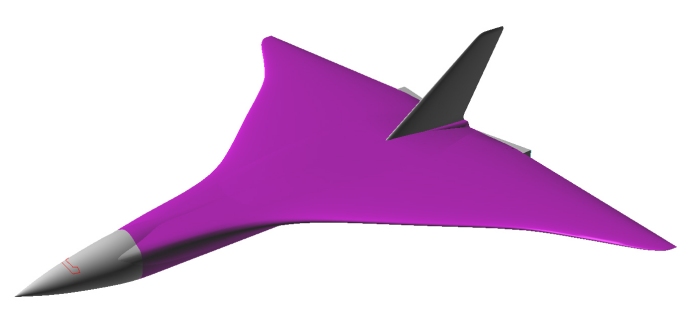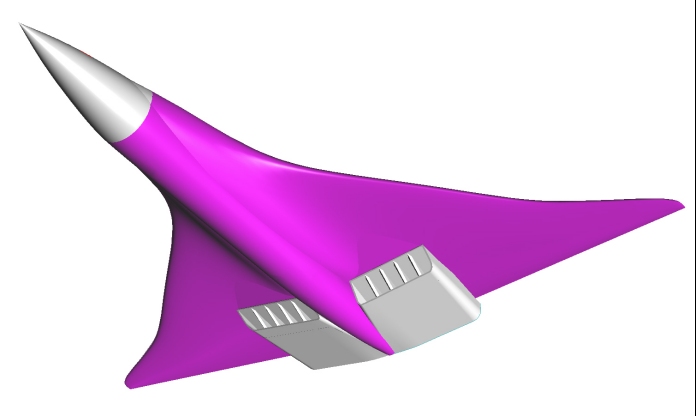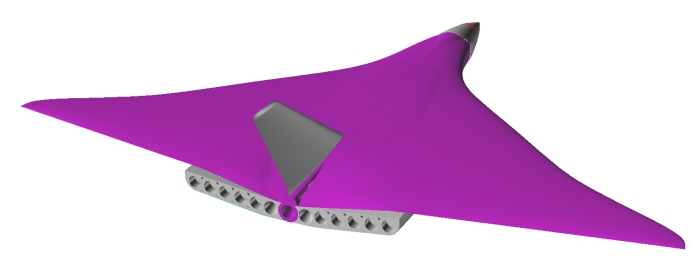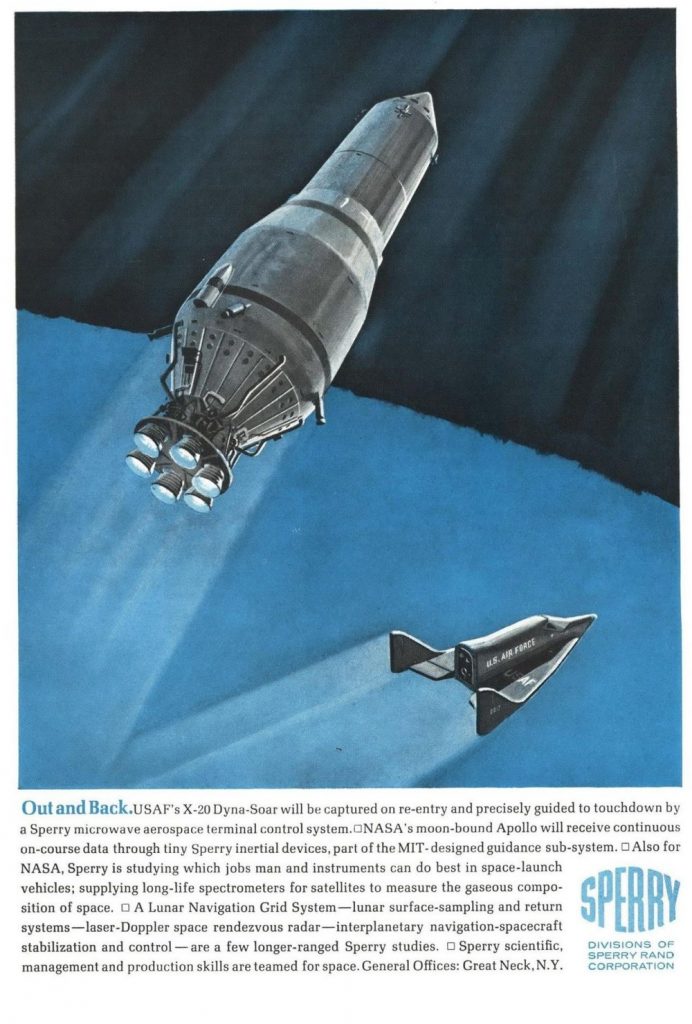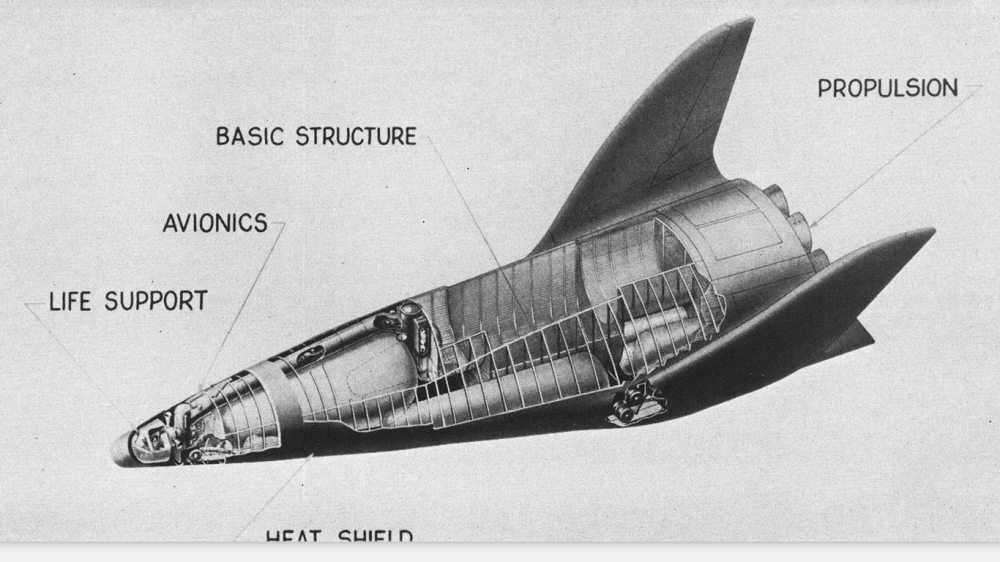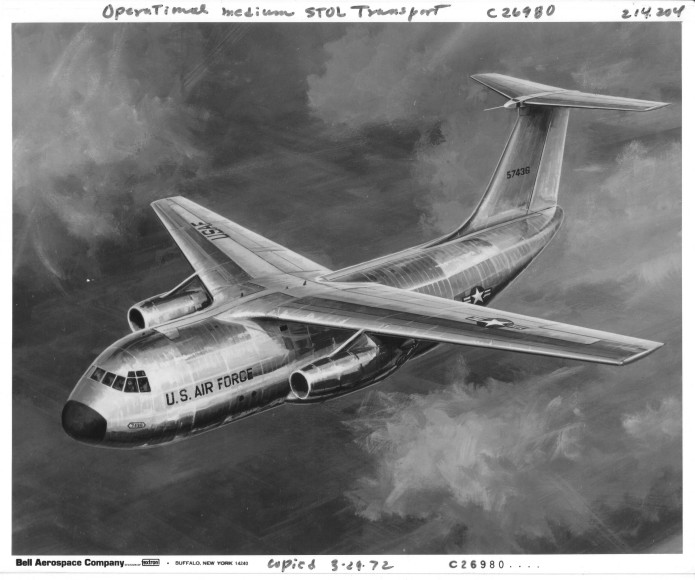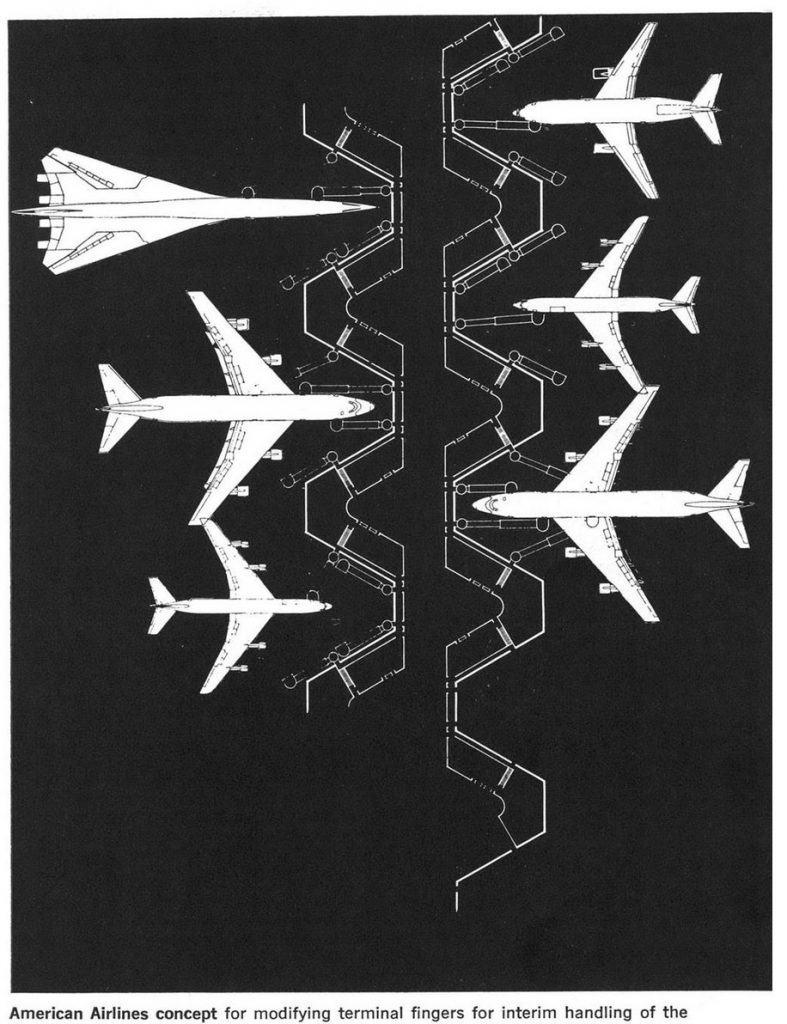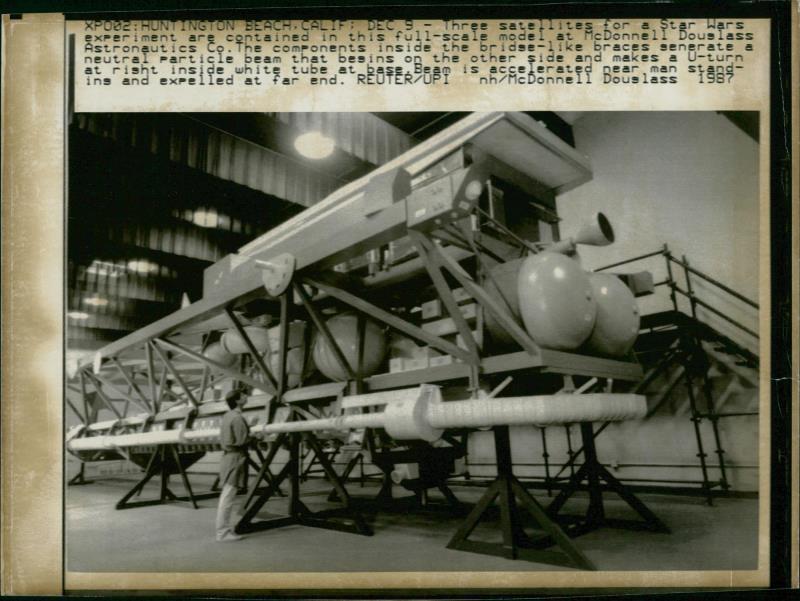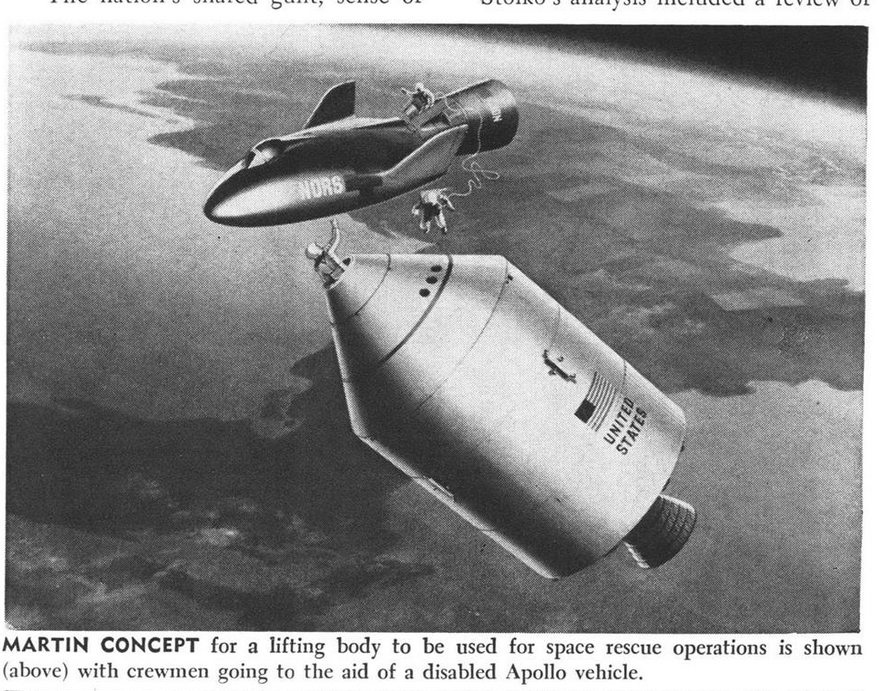A 3D CAD model currently being constructed o the Rockwell “Star Raker.” This is being done in order to nail down diagrams and artwork for a future issue of US Launch Vehicle Projects… and also possibly to serve as the basis of a 1/288 scale model kit.
A magazine ad from 1963 showing the S-IV stage and the X-20 Dyna Soar. The Dyna Soar is shown without its adapter section and Transtage, indicating that it is approaching re-entry (note that it is shown with the canopy heat shield still in place). The Saturn S-IV stage, used on a few Saturn I launches, was smaller than the S-IVB that was used on later Saturn Ib and Saturn V launches, and used six RL-10 rocket engines instead of the S-IVB’s single J-2. Also note the three prominent “ullage rockets” sticking out from the base of the stage. These were small solid rocket motors that would impart a slight forward acceleration to the stage prior to the ignition of the RL-10’s. The acceleration would be high enough and last long enough to settle the propellants into the rears of the tanks. Otherwise the liquid propellants would float around in microgravity and might very well not feed properly into the plumbing system; if a turbopump swallowed a large bubble of gas rather than liquid, it could be destroyed.
The Saturn I/S-IV never launched an actual Apollo CSM, but only boilerplate test articles. Interestingly, the BP-16 test article, launched May 25, 1965, stayed in orbit until July 8, 1989.
A design circa 1970 for a Lockheed lifting body space shuttle concept. This design was derived from the earlier STAR Clipper stage-and-a-half design from the late 1960s… the whole story of the STAR Clipper and its many derivatives is given in Aerospace Projects Review issue V3N2, available HERE.
Note that this vehicle is equipped with sizable internal propellant tanks. As a result the cockpit is separated from the payload bay; in order to access the payload, the crew would need to pass through a long, narrow tunnel not unlike that within the B-36 bomber.
This is just… ewww. No.
Even if the full-scale “drone” picked up the full scale *whole* car and toted it around, it’d still be dubious. But as it is, it picks up *part* of the car. Why? Just fargin’… why? The car would be better if it didn’t split apart. The aircraft would be better if it didn’t split apart. Is it that fookin’ hard to step out of the car, walk ten feet and get into the super-drone?
Come on… are *helicopters*really that challenging a concept?

In 1972 Bell designed a STOL jet transport, a concept that competed for the Advanced Medium STOL Transport role that the McDonnell-Douglas YC-15 and the Boeing YC-14 were built for. The Bell aircraft appeared to be largely conventional in layout, but it was actually quite different from every other transport: the engine nacelles were not only fitted with Harrier-like thrust vectoring nozzles to redirect the core exhaust, the flow could be diverted from the fans to augmenters in the wings. These, it was hoped, would greatly increase static thrust, allowing the aircraft to lift off from unimproved runways in a short distance. As part of their proposal, Bell also designed a proof of concept demonstrator to be built from parts of a C-130. The demonstrator could itself be used as a fair cargo transport, though of course it would not be as well optimized as the all-new vehicles. Unfortunately, the augmenter-wing concept for vertical thrust turned out to be a major disappointment as it steadfastly refused to scale up well.
The demonstrator was recently diagrammed and described in detail in US Recon & Research Projects #03, and the operational version in US Transport Projects #08.
USRP #3 can be downloaded as a PDF file for only $4.25:
USTP #8 can be downloaded as a PDF file for only $4.25:
I’ve uploaded the full rez versions of these scans to the 2018-11 APR Extras folder on Dropbox, available to all APR Patrons at the $4 level and above. If this sort of thing is of interest, please consider signing up for the APR Patreon.
The SST designs of the 1960’s are hardly unknown. But what’s generally not well understood is that designs such as the Boeing 2707 were *huge.* This was considered necessary because SSTs with fuselage lengths in line with existing jetliners – such as the Concorde – would have small passenger capacities due to the need for the fuselages to be *very* narrow compared to their lengths. This, as Concorde showed, was a great way to build an extremely cost-ineffective fuel hog.
So the 2707 would be terribly long and pointy, with a geometry quite a bit unlike regular jetliners. A practical concern is “how do we deal with these things at airports?” If nothing else, the long pointed nose of the SST would put the passenger door considerably further aft than for a conventional rounded-nose jetliners. So, like the 747 and the A380, it was assumed that the larger airports would have to make some infrastructure modifications in order to deal with these new beasts.
The illustration below, from a 1967 issue of Aviation Week, shows American Airlines thinking about the airports of the future. Note that the 2707 is pulled in far closer than the other craft, with the tip of t’s very pointed nose just a few feet away from the building while the others are notably further away. The SST is being serviced by two extendable jetways at maximum extension, while most of the other planes seem to be getting along with just one jetway… though one of the 747s is using four. Note that even though the 747 isn’t pulled in quite as far as the 2707, the SST nonetheless projects much further out into the airfield. For some airports this could well have meant that the taxiways would have been a cluttered mess.
A while back a 1987 press image was posted on ebay showing a McDonnell-Douglas full scale mockup of a Neutral Particle Beam weapon system. This would have been an experimental system, not an operational weapon; details on full-scale NPB weapons are *very* hard to come by, but the smallest NPB weapon system that I’ve seen anything remotely resembling hard data on would have required a non-trivial number of Shuttle-derived heavy lift launch vehicles to put into orbit a piece at a time. Some references – extremely vague ones – have even made mention of dimensions for the full-scale weapons being measured in kilometers.
The purpose of this system would likely have been to simply show that a neutral particle beam could be reliably generated and directed at an orbiting target some decent distance away. While it would likely be very unhealthy to be int he way of such a beam, it’s weapons potential would doubtless have been low… thus the need for vastly scaled-up operational versions.
What is going on with SpaceX and all these Big Falcon Rocket changes?
The design of the BFR has apparently undergone yet another radical change, as-yet undefined. Additionally, the first stage is now called the “Super Heavy” and the upper stage is the “Starship” because Musk claims future versions will indeed go beyond the solar system. Ummm.
On one hand, it’s great that SpaceX is fast on its feet, changing the design as much as needed, as needed. It is of course perfectly normal while devleoping major new designs for there to be a long protracted period of constant design changes, sometimes including radical changes in direction. Take, for example, the long and winding paths Boeing took to the develop the B-52 and B-59 bombers.
On the other hand, it often seems as though these changes of course are driven by personal whim, and every time there’s a redirection there are major delays. This will make even *pretending* to keep to the schedule SpaceX has laid out problematic at best. The upper stage – now “Starship” – is supposed to make test hops in 2019. Hard to do if they’re still designing the thing.
But… SpaceX isn’t NASA. They just might be able to perform.
The 1969 movie “Marooned” featured an Apollo crew stranded in orbit and eventually rescued by a lifting body spacecraft,the fictional “XRV.” It has been noted that the vehicle and the basic setup look a *lot* like an illustration from a 1965 issue of Aviation Week depicting a Martin Co. lifting body rescuing the crew of an Apollo spacecraft:
There is clearly something a little strange going on in this artwork: what may seem like an adapter section or a propulsion module behind the lifting body is actually a docked Gemini spacecraft. There is no explanation for this, but I can speculate. The lifting body is meant to serve as a rescue craft, so it would need to have as much internal space as possible. Not just for three rescued Apollo astronauts, but three astronauts potentially in medical distress. So they might need to be laid out on stretchers, not just sitting in seats. Consequently, while they would need a pilot to get them home and “ambulance staff” to get them squared away, there might not be enough room for everyone. So *perhaps* what’s going on here is that the spaceplane is launched empty or with just a pilot, and the Gemini/Adapter has two EMTs in it. They get the rescuees dealt with and sent home, and they come home in the Gemini. This way, three rescuers go up, but only one comes down taking up space in the lifting body. This is non-optimal, of course; better would be to bring everyone home in one large vehicle. But perhaps this was the best that could be done with the intended launch system, presumably a Titan IIIc.
The lifting body is clearly related to the X-23/X-24 geometry that Martin was beginning to study at the time. A mockup that is very similar, though with the central vertical stabilizer that eventually appeared on the X-24, is shown HERE and HERE.
A combo of computer aided design and machining with low-cost Chinese labor and an expansion in the market for model kits has in recent years led to the availability of model kits the likes of which would have been simply unthinkable when I was a kid. For example: the P.1000 “Ratte.” The Ratte was one of the goofier ideas to come out of Nazi Germany, a 1000 ton tank that used two U-boat diesel engines to haul around a turret from the Tirpitz-class battleships packing two 38-cm cannon. The idea – beloved of Hitler – was clearly insane and while some doodling on the concept was done, no evidence of serious engineering has come to light. It’s the sort of idea that would not be seriously contemplated either as a weapon of war or as a commercial high production run injection molded kits.
Except…
A few years ago, the Chinese model kit company “Takom” released an injection molded kit of the Ratte in 1/144 scale. Even at that small scale the model was good sized, because the design was just that insane. I was honestly a bit shocked that someone would go to the trouble of releasing a 1/144 scale kit of the Ratte. But now there’s this:
A Ratte in 1/72 scale, in a box big enough to make a dog house out of. The company behind this, Modelcollect (another Chinese company), has a whole range of truly befuddling designs. Not only perfectly understandable models like 1/72 B-52s and B-2s and, at long last, a 1/48 A-12 Avenger II, but also a bunch of WWII German tanks redesigned as walking “mechs.” I dunno. Well, the Japanese go bughouse for model kits of ridiculous giant fighting anthropomorphic robots, so maybe the Chinese like quadrupedal King Tiger tanks. Well, there are two billion Chinese, so it doesn’t take a big market share to still end up with a big market.
